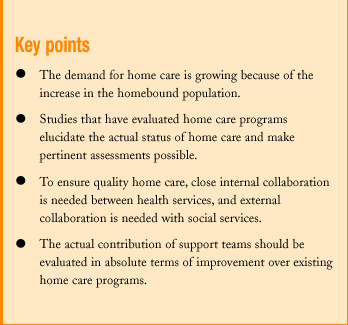Home care is a long-term system of integral and integrated health care provided at the home of persons who, because of illness, cannot travel to the health center. The importance of home care is growing as a result of the increase in the homebound population in the community who need this type of service. Accordingly, the results of the study by the ATDOM (home care) Group of the Catalonian Society of Family and Community Medicine deserve some thought and a few comments.
Implementation of a home care program by more than 90% of all health centers should be considered a very good result, although it cannot be ruled out that the figure might have been lower if the response rate had been higher or if more non-teaching centers had responded. Initially, the results should be interpreted as reflecting a favorable attitude by primary care professionals toward home care, and as an indication that primary care personnel do not share the opinion of detractors of the involvement of the primary care system in home care.
The results of a detailed analysis of the use of specific protocols, however, seem at odds with the widespread availability of home care programs. The low use of protocols for pressure sores in bedridden patients is surprising, as is the low use of protocols for pain management and for terminally ill patients precisely the circumstances that account for many of the patients served by home care programs. These percentages cannot be attributed to differences in the population served, as these specific problems should themselves be considered indicators of the need for home care. Management of these problems should be guided by protocol in most primary care centers, because of their frequency and their impact on the quality of life of patients and their families. A larger study aimed at describing the profile of patients seen in home care may shed light on these apparently contradictory findings.
The study also confirms the important role of community nurses in home care, both as program directors and as the professionals who devote the most time to these programs. However, it should be considered that without meaning to downplay the role of nurses, the time other professionals in the basic health unit devote to home care is usually not great (only 8% of their working day). This might make it difficult to organize home care activities, and could lead to situations in which responsibilities are neglected.1 Data on coverage of the programs and middle-term results (patients whose disease is well controlled, social support resources)2 would make it possible to analyze whether the (relatively small) amounts of time devoted to the program are the result of low commitment by professionals, or appropriate operation of the program, which with time should require less involvement by non-nursing staff at the family medicine unit.
The problems with home care that professionals identified were those usually reported as handicaps for such programs.1 Time constraints make it necessary to chose priorities when responding to needs; logically, highest priority is given to dealing with the burden of care at the health center, to the detriment of home care efforts. However, there are no data that indicate an «actual situation of negligence in providing care» affecting patients in home care programs. A factor that needs to be considered here is whether deficiencies in these programs are the result of inadequacy in social as opposed to medical resources a situation that might, moreover, undermine health practitioners´ motivation to cope continuously with situations that cannot be resolved by health care professionals alone. Further progress in enabling primary care efforts to provide an exclusively medical solution to all the needs of the homebound population is unlikely. Clearly, quality home care can be ensured only if there is close internal cooperation between different health services, and good external cooperation between health and social services.1,3
The study also identifies problems, reported in one-third of all centers, with coordination between different levels of care. These difficulties were noted regardless of the involvement or absence of a support team. The presence of such teams at a large percentage of centers might explain why the lack of coordination between levels of care, although recorded in a non-negligible proportion of cases, was not identified as a problem in the majority of the centers. Despite many attempts, it has not been possible to establish a health care system that operates as a seamless whole, with no gaps in the links between different levels of care. It would be interesting to explore whether the availability of support teams helps to remedy this lack of continuity. If it does not, reflection will be needed on the possible benefits of the creation of a network of care operating in tandem with a primary care system that does not have the capacity to resolve problems in ensuring collaboration between health care and social services.
It remains to be seen whether publication of the findings of this study will inspire health care managers to provide real support for home care programs as models of shared care involving different levels of health and social services. This would undoubtedly require better standardization of care programs and appropriate increases in primary health and social care resources. On the other hand, there is a danger that the findings reported by the ATDOM Group may have no effect, or may skew the interpretation of the results, thus prejudicing most primary care professionals in favor of investing resources in other models of care.







